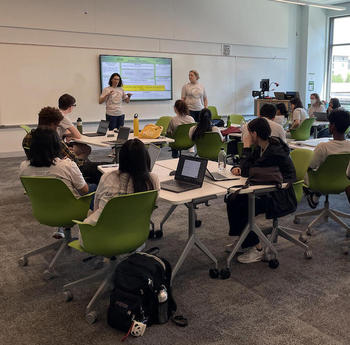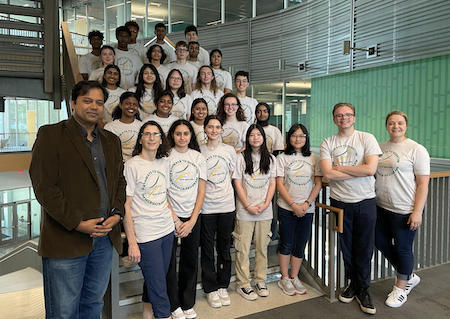Quantum is the study of the universe at the smallest scales. The strange behaviors that occur at the scale of atoms are key to the technologies that power our computers and many other modern devices. Recent advances that allow for greater manipulation of these strange behaviors have propelled quantum into a new era and holds promise for technological advances in computing, sensing, and communications. These new technologies may be the landscape of the workplace for today’s high school students.

To excite high school students about the promise of quantum technologies and to prepare them for this future, George Mason University and Connected DMV held the Pathways to Quantum Immersion Program during July. This program brought together high school students from 21 schools around the metropolitan Washington, D.C., region to explore quantum-focused education, research, and career opportunities.
The transdisciplinary program was coordinated by Jessica Rosenberg, Mason associate professor of physics and director of education at Mason’s Quantum Science and Engineering Center (QSEC), and Nancy Holincheck, Mason College of Education and Human Development Assistant Professor, Associate Director, Center for Social Equity Through Science Education, and co-Academic Program Coordinator of the Advanced Studies in Teaching and Learning program.
Participants began with a two-week virtual program in which they learned about key quantum concepts, engaged with quantum phenomena using polarizers and simulations of experiments including the double slit experiment, learned about applications of quantum technologies, and were introduced to quantum careers.
Following the virtual program, the students spent a week in residence on Mason’s Fairfax Campus for a packed agenda of in-person programming that included lectures, discussions, and visits to sites working on quantum at Mason and around the region.
Participants visited several of the labs engaged in quantum research including Yun Yu’s quantum chemistry lab that is studying two-dimensional materials, Rob Cressman’s biophysics lab that is using quantum sensors to study the brain, Karen Sauer’s physics lab that is developing quantum sensors to detect magnetic fields, and QSEC Director Patrick Vora’s lab to learn about quantum materials research.

“I learned about interdisciplinary, collaborative, and connected research across a variety of quantum topics—some I had already heard about and some emerging fields were new to me,” said Shivani Nadella, a rising senior at Freedom High School in South Riding, Virginia. “The professors were very knowledgeable and excited to share their expertise or resources you need to discover and pursue your passion.”
Nadella was originally planning to pursue a computer science degree when she got to college, but said, as a result of this experience, she is considering a dual major in physics.
Beyond Mason, program participants got to see quantum work that is being done at NASA, University of Maryland, MITRE, and George Washington University. At the NASA Goddard Space Flight Center, the students learned about the role of quantum in communications and got to see quantum labs as well as other facilities like the high bay where the Nancy Grace Roman telescope is being assembled.
At University of Maryland, they got to see lots of quantum labs including a cyclotron and a quantum computer. The MITRE tour included a career panel, as well as visits to the company’s nano-bio and vision-sensing labs. The nano-fabrication facility at George Washington University showed them work being done with scanning and transmitting electron microscopes.
The students’ final visit was to the White House Eisenhower Executive Office for presentations by members of the Office of Science and Technology Policy Quantum coordination office and a tour of the building.
Holincheck said this experience was important for access to opportunities and career information. “The students met diverse scientists working in quantum technologies and quantum policy and heard from them about current and future quantum applications and careers,” she said. “This program is one way that we can provide equitable access to STEM knowledge and opportunities for students from across our region.”
Fairfax County Public Schools Superintendent Michelle Reid said work-based learning experiences like the Quantum Immersion Program help prepare students for careers of the future—careers that don’t yet exist. Nine FCPS students participated in this summer program.
“Our deepest gratitude to our academic, government, and business partners who recognize the value of giving our students hands-on experiences to guide and shape their futures,” she added.
On the final day of the program, participants delivered presentations about what they had learned over the week and their quantum learning continues.
“Some of the students will continue with an extended internship program following this experience,” said Rosenberg. “All of the students also have the opportunity to present a poster on their vision for future quantum technologies the Quantum World Congress occurring in September.”
Rosenberg added, “A student told me that after this experience, they can truly realize how quantum can be applied to many fields—it is the future. They learn whatever career path they choose, whether medical or computational, quantum will be there.”
The Pathways to Quantum Immersion program is part of QSEC’s K12 Quantum Workforce Development Project, which was funded by an appropriation sponsored by U.S. Rep. Jennifer Wexton, and aims to inspire the next generation of students to pursue the field while simultaneously preparing a diverse quantum workforce in Northern Virginia.
“A student told me that after this experience, they can truly realize how quantum can be applied to many fields—it is the future. They learn whatever career path they choose, whether medical or computational, quantum will be there.”
Jessica Rosenberg
